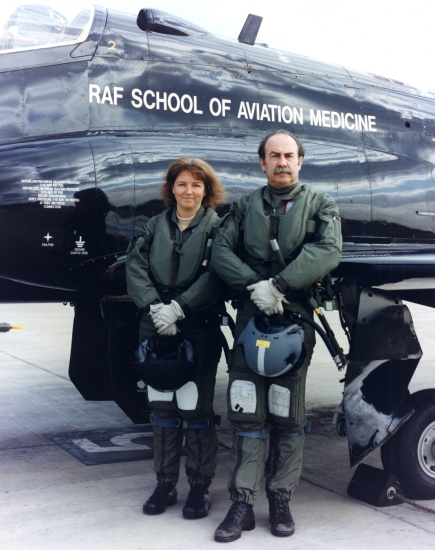Sue Adcock recounts her experience of being a Centrifuge subject and researcher.
Throughout my childhood I was fascinated by military aviation – my ambition was to work in this field and, if a miracle happened, to fly fast jets (FJs) (this was long before the RAF allowed women to fly of course). I loved science at school and, having gained a degree in Mathematics from Oxford University, I went to work at the RAE in 1979 as a research scientist (unusual for a woman in those days). I was involved in several trials on aircraft systems and got to fly as part of the job (including in FJs). I flew in the Hunter, Jaguar, Hawk and Lightning and experienced low level flying, air-to-air combat, air-to-ground bombing and strafing, formation flying, aerobatics, air-to-air refuelling, instrument approaches, circuits, supersonic flight and air tests. I also learnt to fly myself, including aerobatics in a Chipmunk.
In 1989 my husband Terry (an RAF test pilot) was posted to the IAM and was soon acting as a subject in various IAM trials, including the centrifuge. He decided that I shouldn’t be left out of this fun – so he volunteered me to participate in a set of tests at IAM (a practice for the selection tests for the first UK person into space) which included the centrifuge. I well remember my first centrifuge ride. I had already experienced G flying aerobatics and in FJs, so that didn’t bother me. What I was apprehensive about was how I would respond to the coriolis effect – a tumbling sensation experienced at the end of a run as the centrifuge arm slows down and the gondola rotates upright again. It can be so severe as to make some people vomit – as demonstrated by the sick bags helpfully tucked into the gondola door. I needn’t have worried – I only got a very mild tumbling sensation and found I absolutely loved the centrifuge.
I was then enrolled as a centrifuge subject for various IAM trials. One I distinctly remember was a voice recognition trial where we had to recite various words and phrases under different G levels – over and over again. My results were counter-intuitive – my voice recognition improved the higher the G. I did a lot of centrifuge tests on the Typhoon anti-G system, particularly the flying clothing and different pressure schedules. Although the G protection was excellent, there was a downside – the most significant being arm pain, caused by blood pooling in the forearms and hands when held below heart level (eg when holding the stick and throttle). As part of the investigation into this, on some runs I had a sensor inserted into the vein at the back of my wrist to measure venous pressure under the various G levels. Other trials included head balance / movement under G with new or modified helmets (incorporating advanced electronics) which were potentially heavier than existing ones. I had to be very careful to avoid neck injury at higher G, but I found I could move my head safely (albeit slowly) at 8G.

In 1995 I was posted to RAF SAM myself and continued acting as a centrifuge trials subject, only now I also got to fly as a subject (with Terry) in the two SAM Hawk aircraft, which were cleared up to 9.5G. The main activity was to trial all new flying clothing and life support systems for RAF FJ aircraft (particularly Typhoon), first on the centrifuge and then in flight. As I was a qualified pilot, I was allowed to actually fly the aircraft, meaning I could contribute so much more as a subject as the experience is different if you are physically flying the aircraft rather than just sitting there. When I “retired” from flying at the end of 1998 I had accumulated nearly 150 hours in FJs and almost 600 runs on the centrifuge. Happy days and a childhood dream come true.
